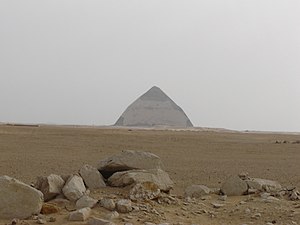Dahshur (Arabic دهشور Dahšūr, often incorrectly rendered in English as Dashur) is an Egyptian archaeological locality some 10 km to the south of Saqqara and therefore 35 km south of the Egyptian capital Cairo.
Understand
edit

Dahshur is best known as a more tranquil, if also more isolated, site in which to visit several large pyramids - at least, when compared to Giza and Saqqara. Visitor numbers are much smaller, queues are way shorter and there is far less hassle.
Inscribed on the UNESCO World Heritage List, Dahshur formed part of the extensive necropolis of ancient Memphis during the Old Kingdom - the so-called "Pyramid Age". The pharaoh Sneferu (sometimes spelt Snofru), founder of the 4th Dynasty and the father to Khufu - builder of the Great Pyramid at Giza) - managed to erect two complete pyramids at the location, in addition to completing another pyramid (for his predecessor Huni) at Meidum. In sheer volume alone, the father definitely out-did his son!
Somewhat later, Pharaohs of the Middle Kingdom's 12th Dynasty erected their own pyramids at the locality - though on a greatly reduced scale.
Dahshur is very much off the traditional tourist trail around Cairo, having been a restricted military zone until 1996. The Egyptian Supreme Council of Antiquities is encouraging travellers to visit Dahshur, in an attempt to relieve some of the pressure on the Giza pyramids.
Get in
editBy tour
editBy taxi
editBy train
editBy metro
editLikewise, you can take a metro to Helwan Station (LE2) and a tuk-tuk from there (LE30-40 as of Jan 2018, not more!). Tuk-tuks aren't allowed into the site, which is a 30-min walk from the gate to the Red Pyramid, and another 20 minutes walk to the Bent Pyramid, with no shade.
Fees and hours
editThe 1 ticket office is about 1 km northwest of Dahshur village, right behind the police checkpoint.
The Dahshur Necropolis site is open daily 8AM-5PM. Tickets are LE100 (as of May 2023).
Get around
editThe Red Pyramid is 2.5 km straight west from the ticket office along the road. The pyramid field extends over 3.5 km north to south, which can be walked or done with the vehicle you arrived with, but as 11/2024 only Red Pyramid and Bent Pyramid are reachable by tourists (there are no trail to walk, and guards prevent you even to try).
See
edit- 1 Red Pyramid (North Pyramid). Also named the Red Pyramid of Sneferu is Egypt's oldest true pyramid (without steps, without bends), probably on account of the red hues of its weathered limestone, now exposed to the elements after the original hard white limestone casing was removed (probably in late antiquity or the medieval period). Some say, however, that the 'red' designation may stem from red graffiti and building marks found around the structure. Well preserved, the Red Pyramid was probably built after the Bent Pyramid, the architects apparently learning from the alterations necessary in the earlier structure, and incorporating the same gentle 43 degree angle used in the upper portion of the Bent Pyramid to construct the Red Pyramid in its entirety. The interior of the Red Pyramid is accessible to the public, after scaling 125 steps. A long, slanting corridor (63 m) leads visitors down to three interior chambers: two antechambers with 12-m-high corbelled vaults and a 15 m high burial chamber with a corbelled ceiling. Human remains, perhaps those of Sneferu, were found in this location. The guy at the pyramid tunnel entrance will request a baksheesh, but the inside is included in your ticket, and you do not have to give him anything just for sitting there..
- 2 Bent Pyramid of Sneferu. Very aptly named, on account of its sudden, startling change in angle halfway up the pyramid, from the steep 54 degrees at the base, to a far more gentle 43 degrees. The angle change was necessary to avoid the pyramid from cracking as it was being built on unstable clay soil. Several rooms in the pyramid are open to visits by the general public.
- 3 White Pyramid of Amenemhat II. It is now nothing more than a pile of rubble, having been heavily quarried for stone. The remaining limestone rubble has given rise to its modern name.
- 4 Black Pyramid of Amenemhat III. This pyramid looks like an ordinary steep hill from apart but it is made of millions of regular black mud bricks. Its state is deteriorating and much of it has been fallen apart, except of it inner part.
- 5 Pyramid of Senusret III (around 1.5 km northeast of Sneferu's Red Pyramid). Built for pharaoh Senusret III of the 12th Dynasty.
- 6 Pyramid of Ameny Qemau. Constructed ca. 1790 BC for Ameny Qemau, the 5th pharaoh of the 13th Dynasty. The stone constituting its upper structure has been entirely robbed but the damaged substructures remain.
- 7 The Forgotten Temple. With two stelae stumps remaining.
- 8 Tombs of royal women of the 12th and 13th dynasties. The tombs are in the center of the necropolis and are arranged in three rows.
Do
edit- Hike around the area from the Red Pyramid, to the Bent Pyramid, to the forgotten Temple, to the Black Pyramid and finally back into Dahshur village.
- Climb down into the Red Pyramid and Bent Pyramid.
Cope
edit- When hiking in summer, take enough water and sun protection with you.
- If you think of hiking directly from Dahshur village to the pyramids, it is possible but guards at the Bent Pyramid and the entrance of the Red Pyramid will unfortunately request your ticket.
Go next
edit- Saqqara – An extensive number of pyramids and tombs on a plateau above the Nile Valley, just north of Dahshur.
- Meidum Pyramid – A forgotten step pyramid in the countryside more than 30 km northeast of Fayum.
- Fayum – A town neglected by most tourists but worth a visit considering the many interesting sites there.

